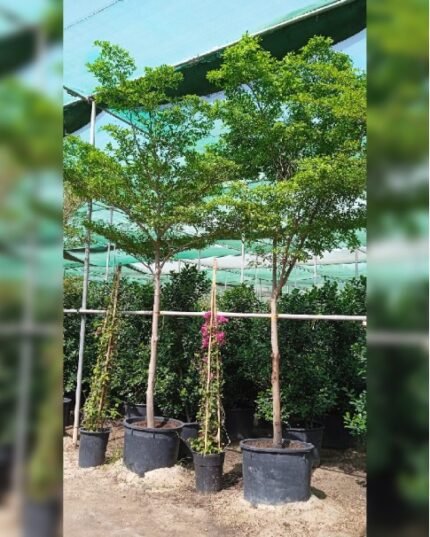Bucida buceras
Bucida buceras, commonly known as the Shady Lady or Black Olive Tree. The Shady Lady tree is celebrated for its captivating and unique appearance. It boasts a slender, upright trunk adorned with dark, peeling bark, lending it the resemblance of an aged olive tree, hence earning it the moniker “Black Olive Tree.” Adorned with dense, cascading branches covered in petite, dark green, oblong leaves reminiscent of olive foliage, this tree maintains its evergreen charm by retaining its leaves year-round. This quality makes it a favored choice for landscaping in tropical and subtropical regions, where it provides a constant source of shade and greenery. Notably, its remarkable ability to offer excellent shade arises from its thick canopy of dark green leaves, creating a refreshingly cool and inviting atmosphere below. Moreover, the Shady Lady tree exhibits impressive salt tolerance, rendering it a suitable choice for coastal locales. It gracefully withstands salt spray and soil salinity, which is why it is often strategically planted along seashores and in seaside landscapes.
Planting & Care
Light: It thrives in bright, indirect sunlight and can tolerate direct sunlight, especially in regions with intense sun. When grown in full sun, it tends to have denser foliage and a more compact growth habit. Young Bucida buceras trees may benefit from some protection from the harsh midday sun, especially during the first few years of growth.
Water: Once Bucida buceras trees are well-established, typically after the first year of planting, they are relatively drought-tolerant. During the spring and summer, water deeply but infrequently. Allow the top of soil to dry out between watering sessions to prevent overwatering. Young Bucida buceras trees may need more consistent moisture to establish their root systems. Water them regularly during their first year, ensuring that the soil remains evenly moist but not waterlogged.
Fertilizer: Bucida buceras is not a fast-growing tree, and it tends to have modest nutritional needs. It doesn’t require frequent or heavy fertilization like some other plants. Use a balanced, slow-release granular fertilizer with an equal ratio of Nitrogen (N), Phosphorus (P), and Potassium (K). This balanced fertilizer provides essential nutrients for overall tree health.
Temperature: Ideally, the tree prefers temperatures between 70°F to 90°F (21°C to 32°C).
Potting: Choose a container that provides ample space for the tree’s roots to grow. The pot should be at least 2-3 times larger in diameter than the tree’s current root ball. This ensures enough room for root expansion and prevents the tree from becoming root-bound. Select a pot with drainage holes at the bottom. Proper drainage is crucial to prevent waterlogging, which can lead to root rot.
Pruning: Regularly inspect the tree for dead, damaged, or diseased branches. Prune these branches back to healthy tissue to prevent the spread of disease and improve the overall appearance of the tree. If the tree becomes overly dense with foliage, you can selectively thin out branches to improve air circulation and reduce the risk of fungal issues.
















